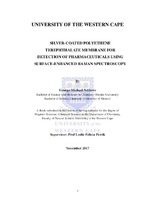| dc.description.abstract | Surface-enhanced Raman spectroscopy (SERS) has emerged as one of the
analytical tools for detection of micro pollutants in the aquatic environment. The
SERS technique is touted to have fingerprinting capability, specificity, ease of
operation and single-molecule sensitivity. Therefore SERS can be used for
detection of trace level organic pollutants in water. Trace level aquatic micro
pollutants such as pharmaceuticals, have been detected in effluents from water
treatment plants. Pharmaceuticals, due to the intended therapeutic use, may have
adverse effects on living organisms, even in trace-level concentrations.
Furthermore, the growing interest to reuse wastewater to augment conventional
water supplies has resulted in a growing demand to explore sensitive and rapid
analytical techniques such as SERS. In addition the use of track-etched polymer
membranes in the filtration process has attracted considerable attention due to
their flexibility in providing shape, durability and pore size control versatility. In
this work, a silver-coated track-etched polyethene terephthalate (PET) membrane
was developed as a platform to detect acetaminophen and had its surface-enhance
Raman properties evaluated. The silver-coated track-etched PET membrane was
fabricated by modifying the surface of the PET membrane with
diethylenetriamine (DETA) via solid-liquid interface reaction known as
aminolysis. The characterisation techniques used to ascertain the surface
modification of track-etched PET membrane are Fourier transform infrared
(FTIR), X-ray photoelectron spectroscopy (XPS). Silver nanoparticles were
immobilised on the amine-modified surface of track-etched polyethene
terephthalate membrane by immersing an amine-modified track-etched PET
membrane in a 102 mL mixture of 1 mM of silver nitrate and 1% trisodium
citrate heated at 90 oC for 30 minutes. The immobilised silver nanoparticles were
of varying sizes with an average size of 62 nm and mostly of spherical shape.
The successful immobilisation of silver nanoparticles on modified track-etched
PET membrane was further characterised by ultraviolet-visible (UV-Vis)
spectroscopy, scanning electron microscopy (SEM) and X-ray photoelectron
spectroscopy (XPS). | |

